This iKamper Skycamp 2.0 review is about the 2019 – upgraded – version of the original Skycamp (called Skycamp 4X).
The iKamper Skycamp 2.0, similarly to the earlier version, is a 4-person -berth hard-shell roof tent. It’s design uniquely features the benefits of a hard-top rooftent and the interior space of a traditional soft-shell roof tent, thus offering large space packed in a small and lightweight package.
Let’s have a look at the iKamper Skycamp 4X 2.0 in detail, because I have a feeling that some of the features, that sound really good, are actually not more than a clever marketing slogan…
Quick Summary – iKamper Skycamp 4X 2.0
[rank_math_rich_snippet]| PROS |
| - Lightweight - Large internal space - Easy setup <60 sec |
| CONS |
| - Thin mattress - Polyester flysheet |
Who is the iKamper Skycamp 4X 2.0 for?
The iKamper Skycamp 2.0 is almost perfect for couples and smaller families with one or two (smaller) children. The interior space is generous, the Skycamp 2.0 feels light and airy, setup is a piece of cake.
Where to Buy the iKamper Skycamp 4X 2.0?
You can visit the official website of iKamper at ikamper.com and place your order through their website. There are official dealers around the world too, you can find their location here https://www.ikamper.com/pages/locations .
About iKamper
iKamper is a small, family-owned company from South Korea. It was founded in 2012 by Soon Park, who lived in the States between 2008 and 2012. During these years he and his family spent almost 2 years on the road camping and exploring. When they finally returned to South Korea Soon founded iKamper.
After the moderate success of their first product he launched a Kickstarter campaign for Skycamper in 2017. This became a huge crowdfunding success and raised $2.37 million in 45 days.
iKamper Skycamp 2.0 Review
Exteriors
The Skycamp 2.0 comes in three different colors: black, rocky black and white. So if you like black you have plenty of choice 🙂 sorry I did not want to be mean. The Skycamp 2.0 actually looks quite modern, it has a nice, streamlined shape when closed, that helps reducing wind-noise during transport and it has better miles to the gallon.
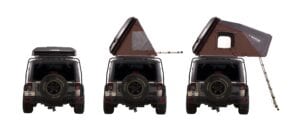
iKamper Skycamp 2.0 – a lot of good stuff in a small space
While most hard-shell rooftents have a single-layer hard shell, the hard fibre-reinforced plastic top of the Skycamp has TWO layers.
This does not affect how the Skycamp 2.0 looks like – it pretty much looks the same as it’s predecessor or other hardshell roof top tents – as much as the it helps reducing noise and improving thermal insulation when in use: it is less likely you experience condensation appearing on the inner side of the hard shell. (later on that)
The outer shell is 218 cms long (the baseplate is 200 cms), the height of the lid in a closed position is 32 cms at it’s highest point. That’s very low…
The width of the Skycamp with closed lids is 138 cms – this is the normal width of a larger hard-shell roof tent (just to show you how brilliant the design is).
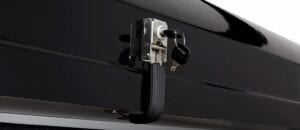
Security locks on the iKamper Skycamp’s hard shell
There are also hard-shell security locks available to order, but you can’t install them retrospectively: they must be fitted in the factory (and if they break, you can replace them for $60).
Weight & Fitting
The Skycamp 2.0 is the largest iKamper roof tent and it weighs 73 kgs. So its really pushing the limit that most compact cars have for dynamic load capacity: with mounting and the weight of the roofracks we are well over 80-85 kgs. It makes the iKamper Skycamp 2.0 incompatible with smaller compact / estate cars.
Find out roof weight limit of your car here:
You should also bear in mind that this is a heavy lift onto the top of your car…even with two men.
In terms of fitting, the other limiting factor is the minimum of 76 cms you must have between the two crossbars – however, most cars can meet this requirement;
The ladder is 211 cms long, which is, again, fine for most vehicles (e.g. a Land Rover Discovery is 188 cms high), however you won’t fit the iKamper Skycamp on top of a VW Transporter for example without the ladder extension ($55 / step).
But when I say fine I mean that it would probably be very steep. Partly because the ladder must also support some of the weight.
Cheeky iKamper though…the iKamper Skycamp 2X – the smaller sibling – used to come with longer ladders: you could select between 3 lengths, even the shortest was longer than this.
Pitching
I was going to say that the real deal with the Skycamp is the pitching time: its under (or around) 60 seconds.
If you compare it to other hard-shell tents, its not outstanding. Thanks to their gas-assisted struts and their clever mechanism, other fibre-shell rooftents are just as easy to set up under a minute as the iKamper Skycamp 2.0.
You can’t blame the iKamper Skycamp 2.0 though, I can’t stress enough that its much bigger than other hard-shell or rooftents. Parking your car on a level surface, unlocking the roof, folding out the fibreglass shell does not take long. You set the telescopic ladder to right height, and then you climb up to peg out the front canopy and – if necessary – the rainflaps on the windows.
Closing is just as easy, although it takes some practice to handle the reins: the clever straps to ensure that the fabric is tucked in as you slowly close the lid.
Fabrics & Weather Resilience
The Skycamp has a 2nd layer of protection in the form of a detachable flysheet, which is not very common among rooftop tents. Other makes tend to have one, very thick polycotton layer.
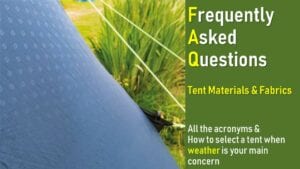 Polycotton is a great tent material, because it is lightweight, durable, waterproof and it has good thermal properties which is important to avoid condensation building up inside the tent.
Polycotton is a great tent material, because it is lightweight, durable, waterproof and it has good thermal properties which is important to avoid condensation building up inside the tent.
The Skycamp 2.0 has a 300gsm thich polycotton wall, and there’s a flysheet laid on top of it too.
The flysheet is made of a 150D polyester fabric with water-proof coating, it has 3000mm HH (Hydrostatic Head) rating.
Related Post if you have no clue what I am talking about: Tent materials, fabrics, specifications and all the acronyms. FAQ.
To be completely honest I don’t really see the point of having a polyester flysheet on top of a polycotton tent, for two reasons:
The polycotton tent could have got that waterproving PU layer too (it probably has anyways). The polyester flysheet, despite being relatively thick, has far worse thermal properties.
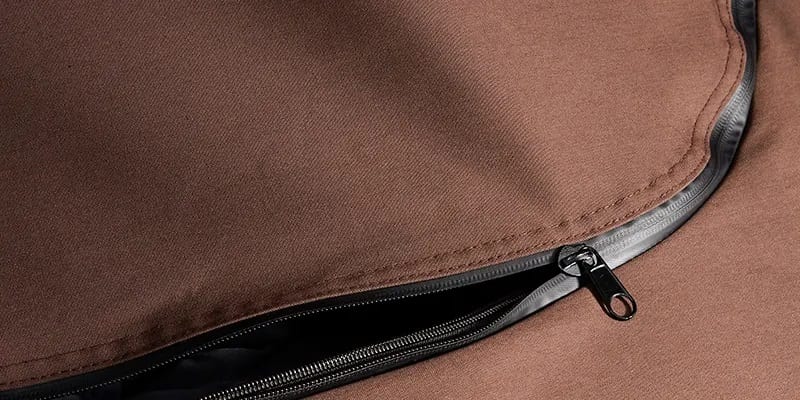
Polycotton tent canvas – high quality tent fabric, and waterproof zippers on the iKamper Skycamp
Although it would keep the rainwater out, easily, in colder mornings condensation will probably build up between the tent wall and the flysheet. It also eliminates the benefit of having a polycotton tent – polycotton fabric is breathable (much less likely to build up condensation inside), while polyester is not.
No wonder, that iKamper has a dedicated section in their F.A.Q. for ‘is condensation normal?‘, explaining that it is. Well, not so much for a polycotton tent, but if you cover it with non-breathable polyester…
Also, if you don’t make sure that you regularly remove the flysheet and dry it out properly, you can expect that funny smell of mold appearing in no time, and then there’s no way you will remove that greenish coloring from within the fibres of the canvas.

The Skycamp has a detachable flysheet – a good idea to prevent molding between the polyester flysheet and the polycotton tent wall. The only question is: WHY??? 🙁
Apart from this, you should not worry about weather resilience, as long as you shut the roof window properly. The seams and the zippers are taped, the tent fabric is waterproof.
Users of the early models reported that the Skycamp could not withstand stronger winds – but stronger meant a normal windy weather. Where other tents had no issues keeping their shape, the early Skycamps tended to lose height as the stabilizing rods could not bear the weight of the hard shell pressed by the wind, and they bent. In fact, the maximum recommended wind speed was 33 kmh (20 mph) for all models. A wind this strong would not even bend trees.
Anyways, Skycamp must have improved the design now, and they also tested all their tents up to 64 kmh (40 mph), which is classed as ‘Gale Force’ wind. However, the recommended maximum wind speed which you should pitch the Skycamp rooftents in, remained 20 mph.
As s for upgrades, the Skycamp 2.0 is much well equipped than it’s smaller sibling. You can add extra front annex or a front canopy, which is great, no other hard shell tent has an annex. This is where the smart design proves itself: enjoying the benefits of a soft shell tent with a hard-shell protection.
Inside the Skycamp 2.0
One of the main selling points, large interiors. iKamper says that the Skycamp 4X and the Skycamp 2.0 are a 4-person tent. This may be true, if every one of you are extremely short, but to be fair, 4 people won’t sleep comfortably in the Skycamp. Or no-one will sleep at all…
The width of the Skycamp is 218 cm at the hard shell, the useful space inside is slightly less. The total width at the ladder, where your feet would be is only 190 cms. Divided by 4, that’s only 47 cms per person, 55-57 near the shoulders / head.
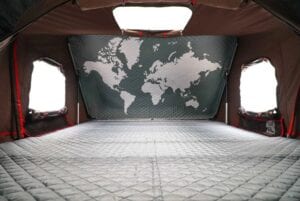
Eye-catching interiors – inside the Skycamp 2.0
Even if you travel with two smaller children, it is a bit tight, but doable.
So I think its safe to say that the iKamper Skycamp is comfortable for 3 adults.
The headspace, on the other hand, is unfortunately less than the average. The internal height is only 110 cms, which is much less than the headroom of around 130cms that you get in other hardshell roof tents.
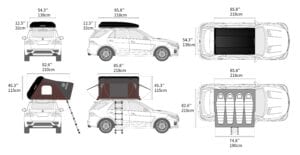
External and internal dimensions of the Skycamp 2.0
Also, there are not too many pockets either, but you can buy extra pockets…again, not usual but fair enough. The additional inner corner shelf for smartphones, torches, glasses etc is sold for $25 looks tiny and a bit flimsy, but it is better than nothing. There is an outer storage shelf as well (for $59) with 4 large pockets for camping gear, utensils etc. that hangs right next to the ladder.
On the other hand, the Skycamp feels light and roomy thanks to the skywindow, the two windows on the sides, and the large entrance door.
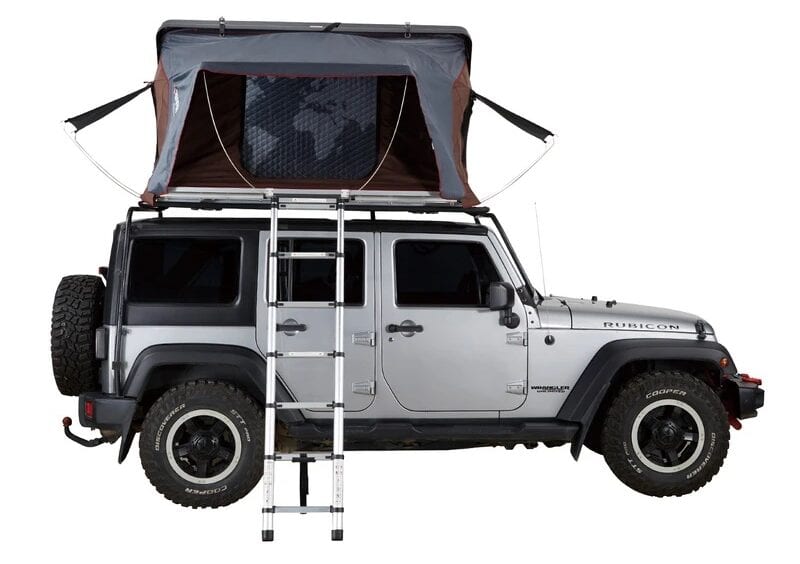
iKamper Skycamp 2.0
The materials used inside feel high quality, apart from the mattress that has received quite a few negative comments: albeit being made of memory foam, and it is now 50% thicker than the original in the Skycamp 4x, it is still too thin. The original was only 4.5 cms thin, so 50% improvement is still not a lot, the mattress is only 7 cms long.
I suggest you try it out first and if you are not happy with the comfort level the factory mattress provides, get rid of it. You can easily fit a super king size mattress of your choice inside; however, at this price range iKamper really should not save pennies on the mattress.
You should also bear in mind, that the Skycamp has a very low profile. If the mattress is too thick, you may lose storage space for the bedding. According to customer reviews, a thicker / bigger size bedding would not fit inside when the lid is closed. There seems to be no issue with ‘normal size’ bedding, but the actual ‘storage capacity’ is somewhat limited.
Warranty & Customer Service
Kamper offers a 2+3 year warranty on the Skycamp (2 year full, 3 year limited) for your peace of mind.
Alternatives
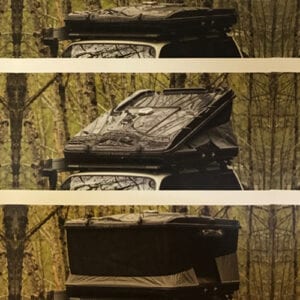
The only ??? alternative to the iKamper Skycamp 2.0 – James Baroud XXL tents for 3 people
Apart from some less known manufacturers who seem to have stolen the design, there is (still) no real competition or alternative for the Skycamp 2.0.
In terms of size and weather-resilience, there are bigger and better soft shell tents. But those are bulkier, heavier, and don’t have a fibre-reinforced double-layer plastic shell. The iKamper X-Cover could be a good alternative, and although the X-Cover is slightly smaller, it has other benefits…not to mention the much-friendlier price tag.
iKamper X Cover v Skycamp 2.0 – Detailed Comparison with a surprising outcome.
There are other hardshell rooftents as slim as the Skycamp, but even the bigger ones are going to be slightly smaller and slightly more expensive. One that I can think of is the James Baroud Space XXL, which is 3-person tent, offering 162 cms width inside.
To be honest, I don’t really like having a polyester flysheet over a polycotton tent.
You can at least remove it – the polycotton tent should remain waterproof anyways in lighter rain or drizzle.
The only copycat I would ever consider is the Roofnest Condor. To be frank, despite that in this detailed comparison of the Roofnest Condors vs the iKampers the iKampers Skycamps don’t look very good, I prefer the design of theirs. But it may be worth considering that $500 advantage in price the Roofnest Condor has.
Also, if you live in the UK, check out this round-up post of the cheapest yet very decent roof top tents: TOP 10 Cheap Roof Tent 2020 UK
[rank_math_rich_snippet]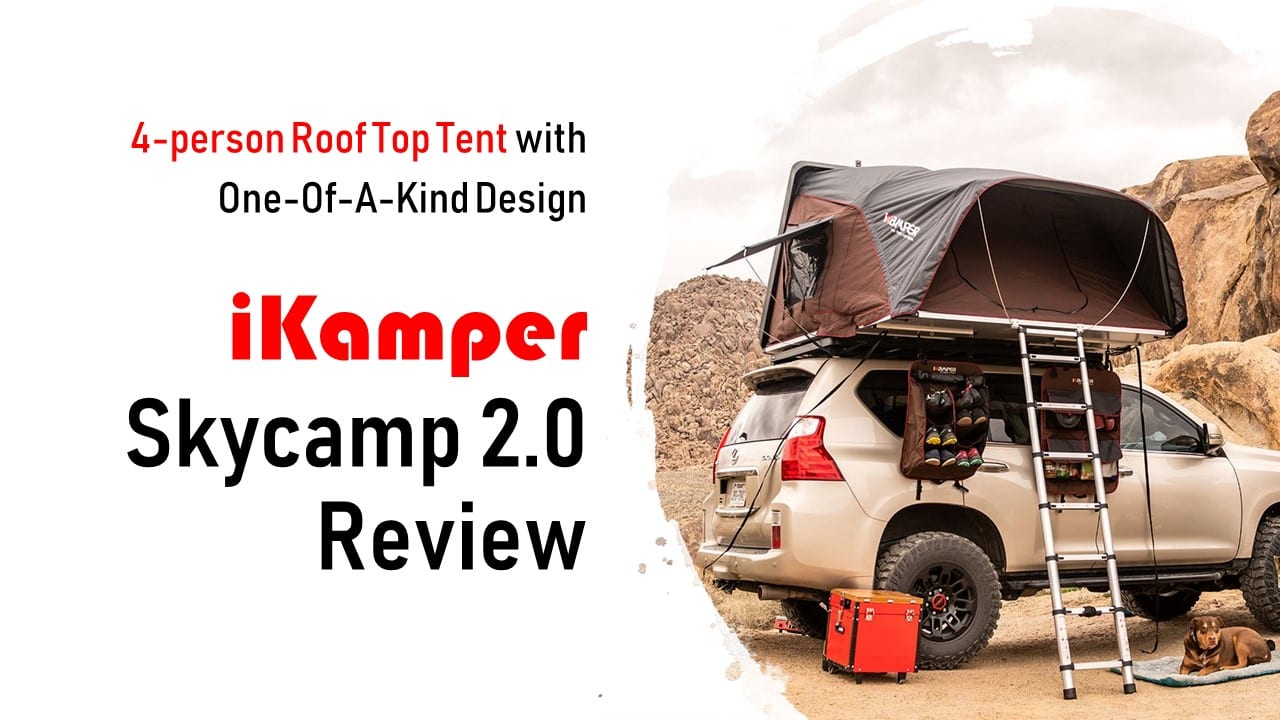

While I thought I’d like the RTT I never got the chance. Customer Service cut me short of doing so when they partnered with Affirm Financing and I was being charged 30% interest. I ordered at 9 PM at night then canceled at 5 AM in the morning, less than 8 hours later explaining I was going to obtain better finance rate prior to my purchase.
They did cancel, but charged me 3.5% of my 4400.00 order saying their web site has this policy written.
So therefore they can take 8 weeks to fulfill my order but I can’t take 8 hours to change my mind on an on-line order.
Customer Service was a pain to work with during this order and cancellation, so I decided to shop another brand as I felt this would be a reflection of what I’ll deal with when problems occur after purchase.
I felt they have absolutely no care or respect for the customer, only there to make sales. Will not ever consider any purchases from iKamper in the future and this issue could not be resolved
Hey Randy,
Sorry to hear about your experience and thanks for sharing. Sounds really unfair.
What Rtt did you get instead of the iKamper?